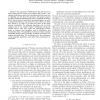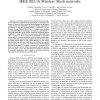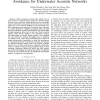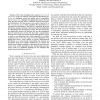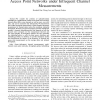INFOCOM
2007
IEEE
14 years 6 months ago
2007
IEEE
— Many network applications are based on a group communications model where one party sends messages to a large number of authorized recipients and/or receives messages from mult...
INFOCOM
2007
IEEE
14 years 6 months ago
2007
IEEE
— The popularity of IEEE 802.11 WLANs has led to dense deployments in urban areas. High density leads to suboptimal performance unless the interfering networks learn how to optim...
INFOCOM
2007
IEEE
14 years 6 months ago
2007
IEEE
—802.11a, b, and g standards were designed for deployment in cooperative environments, and hence do not include mechanisms to protect from jamming attacks. In this paper, we expl...
INFOCOM
2007
IEEE
14 years 6 months ago
2007
IEEE
Abstract— In wireless mesh networks, the end-to-end throughput of traffic flows depends on the path length, i.e. the higher the number of hops, the lower becomes the throughput...
INFOCOM
2007
IEEE
14 years 6 months ago
2007
IEEE
— Unlike terrestrial networks that mainly rely on radio waves for communications, underwater networks utilize acoustic waves, which have comparatively lower loss and longer range...
INFOCOM
2007
IEEE
14 years 6 months ago
2007
IEEE
—We study the problem of supporting VoIP calls in a wireless mesh network. Specifically, we propose solutions for call admission control (CAC) and route selection for VoIP calls...
INFOCOM
2007
IEEE
14 years 6 months ago
2007
IEEE
We study the interaction among users of unstructured file sharing applications, who compete for available network resources (link bandwidth or capacity) by opening multiple conne...
INFOCOM
2007
IEEE
14 years 6 months ago
2007
IEEE
— This work investigates three aspects: (a) a network vulnerability as the non-uniform vulnerable-host distribution, (b) threats, i.e., intelligent worms that exploit such a vuln...
INFOCOM
2007
IEEE
14 years 6 months ago
2007
IEEE
INFOCOM
2007
IEEE
14 years 6 months ago
2007
IEEE
—We consider the problem of uplink/downlink scheduling in a multichannel wireless access point network where channel states differ across channels as well as users, vary with tim...

